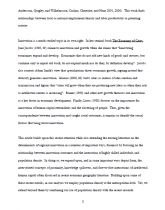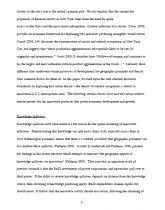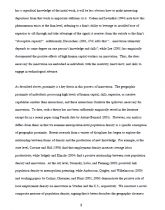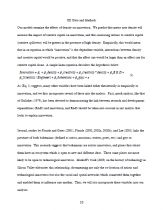Hledej
Zobraz:
Univerzity
Kategorie
Rozšířené vyhledávání
12 662
projektů
Urban density, creativity and innovation
| Přípona |
Typ projekt |
Stažené 0 x |
| Velikost 0,6 MB |
Jazyk anglický |
ID projektu 2936 |
| Poslední úprava 27.03.2014 |
Zobrazeno 1 013 x |
Autor: eliseus |
 Sdílej na Facebooku
Sdílej na Facebooku |
||
| Detaily projektu | ||
- Cena:
2 Kreditů - kvalita:
85,8% -
Stáhni
- Přidej na srovnání
- Univerzita:Univerzita Tomáše Bati ve Zlíně
- Fakulta:Fakulta managementu a ekonomiky
- Kategorie:Ekonomika » Management
- Předmět:Management
- Studijní obor:-
- Ročník:-
- Formát:PDF dokument (.pdf)
- Rozsah A4:40 stran
Geographers and social scientists have probed the effects of agglomeration and spatial
clustering on innovation and economic growth. Economists and others have identified the role of
knowledge spillovers in driving the innovation process. While innovation is thus assumed to be a
function of proximity, there has been little systematic research on the role of density in innovation.
Thus, this research investigates density, and more specifically the density of creative workers, as a
key factor influencing regional innovation. It uses principal components analysis to create and
implement a composite measure of density and presents a model of innovation as a function of
creative-density. Statistical analyses including multivariate regression finds that density and creativity
separately and jointly affect innovation in metropolitan areas. The regression analysis finds a
positive relationship between the density of creative workers and metropolitan patenting activity.
This suggests that density is a key component of knowledge spillovers and a key component of
innovation
clustering on innovation and economic growth. Economists and others have identified the role of
knowledge spillovers in driving the innovation process. While innovation is thus assumed to be a
function of proximity, there has been little systematic research on the role of density in innovation.
Thus, this research investigates density, and more specifically the density of creative workers, as a
key factor influencing regional innovation. It uses principal components analysis to create and
implement a composite measure of density and presents a model of innovation as a function of
creative-density. Statistical analyses including multivariate regression finds that density and creativity
separately and jointly affect innovation in metropolitan areas. The regression analysis finds a
positive relationship between the density of creative workers and metropolitan patenting activity.
This suggests that density is a key component of knowledge spillovers and a key component of
innovation
Klíčová slova:
Creativity
Density
Innovation
Learning
Spillovers
Obsah:
- Abstract:
Keywords
I. Introduction
II. Concepts and Theory
III. Data and Methods
IV. Findings
V. Conclusions
References
Zdroje:
- Almeida, P., and Kogut., B. 1999. Localization of Knowledge and the Mobility of Engineers in Regional Networks. Management Science 45: 905-917.
- Andersson, R.; Quigley, J.; and Wilhelmsson, M. 2005. Agglomeration and the spatial distribution of creativity. Papers in Regional Science 84: 445-464.
- Anselin, L.; Varga, A.; and Acs, Z. 2000. Geographical Spillovers and University Research: A Spatial Econometric Perspective. Growth and Change 31:501-515.
- Asheim, B. 2000. Industrial Districts: The Contributions of Marshall and Beyond. In The Oxford Handbook of Economic Geography, eds. G. Clark, M. Gertler, and M. Feldman, 413-31.
- Oxford,UK: Oxford University Press. Audretsch, D., and Feldman, M. 1996. R&D Spillovers and the Geography of Innovation and Production. The American Economic Review 86:630-640.
- Autant-Bernard, C. 2001. The Geography of Knowledge Spillovers and Technological Proximity. Economics of Innovation and New Technology 10:237-254.
- Bathelt, H.; Malmberg, A.; and Maskell, P. 2004. Clusters and knowledge: local buzz, global pipelines and the process of knowledge creation. Progress in Human Geography 28:31-56.
- Black, D.; Gates, G.; Sanders, S.; and Taylor, L. 2000. Demographics of the Gay and Lesbian Population in the United States: Evidence from Available Systematic Data Sources. Demography 37:139-154.
- Bunnell, T., and Coe, N. 2001. Spaces and scales of innovation. Progress in Human Geography 25:569-589.
- Carlino, G.; Chaterjee, S.; and Hunt, R. 2001. Knowledge Spillovers and the New Economy of Cities. Working Paper No. 01-14, Federal Reserve Bank of Philadelphia. 2006.
- Urban Density and the Rate of Invention. Working Paper No. 06-14, Federal Reserve Bank of Philadelphia.
- Caves, R. 2002. Creative Industries: Contracts between Art and Commerce. Cambridge, MA: Harvard University Press.
- Ceh, B. 2001. Regional innovation potential in the United States: Evidence of spatial transformation. Papers in Regional Science 80:297-316.
- Chapple, K.; Markusen, A.; Schrock, G.; Yamamoto, D.; and Pingkang, Y. 2004. Gauging Metropolitan “High-Tech” and “I-Tech” Activity. Economic Development Quarterly 18:10-29.
- Ciccone, A., and Hall, R. 1996. Productivity and the Density of Economic Activity. The American Economic Review 86:54-70.



